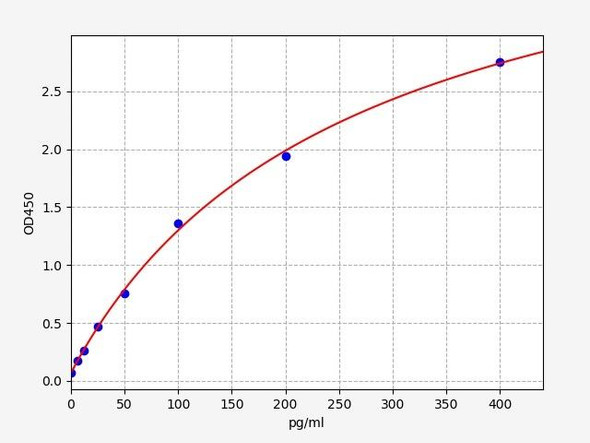Rat Bcl-2 ELISA Kit
- SKU:
- RTFI00593
- Product Type:
- ELISA Kit
- Size:
- 96 Assays
- Uniprot:
- P49950
- Sensitivity:
- 0.094ng/ml
- Range:
- 0.156-10ng/ml
- ELISA Type:
- Sandwich ELISA, Double Antibody
- Synonyms:
- BCL-2, B-Cell Leukemia, Lymphoma 2, apoptosis regulator Bcl-2
- Reactivity:
- Rat
Description
| Product Name: | Rat BCL-2 (B-Cell Leukemia/Lymphoma 2) ELISA Kit |
| Product Code: | RTFI00593 |
| Size: | 96 Assays |
| Target: | Rat BCL-2 |
| Alias: | BCL-2, B-Cell Leukemia, Lymphoma 2, apoptosis regulator Bcl-2 |
| Reactivity: | Rat |
| Detection Method: | Sandwich ELISA, Double Antibody |
| Sensitivity: | 0.094ng/ml |
| Range: | 0.156-10ng/ml |
| Storage: | 4°C for 6 months |
| Note: | For Research Use Only |
| Recovery: | Matrices listed below were spiked with certain level of Rat BCL-2 and the recovery rates were calculated by comparing the measured value to the expected amount of Rat BCL-2 in samples. | ||||||||||||||||
| |||||||||||||||||
| Linearity: | The linearity of the kit was assayed by testing samples spiked with appropriate concentration of Rat BCL-2 and their serial dilutions. The results were demonstrated by the percentage of calculated concentration to the expected. | ||||||||||||||||
| |||||||||||||||||
| Intra-Assay: | CV <8% | ||||||||||||||||
| Inter-Assay: | CV <10% |
| Uniprot: | P49950 |
| UniProt Protein Function: | Bcl-2: a antiapoptotic member of the Bcl-2 family. Regulates cell death by controlling the mitochondrial membrane permeability. Inhibits caspase activity either by preventing the release of cytochrome c from the mitochondria and/or by binding to the apoptosis-activating factor (APAF-1). Phosphorylation by JNKs may increase its antiapoptotic functions. |
| UniProt Protein Details: | Protein type:Membrane protein, integral; Apoptosis; Autophagy; Oncoprotein Cellular Component: cytoplasm; cytosol; endoplasmic reticulum; endoplasmic reticulum membrane; integral to membrane; intracellular; membrane; mitochondrial membrane; mitochondrial outer membrane; mitochondrion; myelin sheath; nuclear membrane; nucleus; perinuclear region of cytoplasm; pore complex Molecular Function:BH domain binding; BH3 domain binding; channel activity; channel inhibitor activity; identical protein binding; protease binding; protein binding; protein heterodimerization activity; protein homodimerization activity; protein phosphatase 2A binding; protein phosphatase binding; sequence-specific DNA binding; transcription factor binding; ubiquitin protein ligase binding Biological Process: actin filament organization; aging; apoptosis; apoptotic mitochondrial changes; axon regeneration; axonogenesis; B cell differentiation; B cell homeostasis; B cell lineage commitment; B cell proliferation; B cell receptor signaling pathway; behavioral fear response; brain development; CD8-positive, alpha-beta T cell lineage commitment; cell aging; cell growth; cell morphogenesis; cell proliferation; cell-cell adhesion; cellular calcium ion homeostasis; cellular response to glucose starvation; cochlear nucleus development; defense response to virus; developmental growth; digestive tract morphogenesis; DNA damage response, signal transduction resulting in induction of apoptosis; ear development; endoplasmic reticulum calcium ion homeostasis; focal adhesion formation; gland morphogenesis; glomerulus development; growth; hair follicle morphogenesis; hemopoiesis; homeostasis of number of cells within a tissue; immune system development; induction of apoptosis by oxidative stress; induction of apoptosis via death domain receptors; kidney development; leukocyte homeostasis; lymphocyte homeostasis; lymphoid progenitor cell differentiation; male gonad development; melanin metabolic process; melanocyte differentiation; mesenchymal cell development; metanephros development; negative regulation of apoptosis; negative regulation of autophagy; negative regulation of cell growth; negative regulation of cell migration; negative regulation of cell proliferation; negative regulation of cellular pH reduction; negative regulation of mitotic cell cycle; negative regulation of myeloid cell apoptosis; negative regulation of neuron apoptosis; negative regulation of ossification; negative regulation of osteoblast proliferation; negative regulation of retinal cell programmed cell death; neuron apoptosis; oligodendrocyte differentiation; oocyte development; organ growth; organ morphogenesis; ossification; ovarian follicle development; peptidyl-serine phosphorylation; peptidyl-threonine phosphorylation; pigment granule organization and biogenesis; pigmentation; pigmentation during development; positive regulation of B cell proliferation; positive regulation of catalytic activity; positive regulation of cell growth; positive regulation of cell proliferation; positive regulation of melanocyte differentiation; positive regulation of multicellular organism growth; positive regulation of neuron maturation; positive regulation of peptidyl-serine phosphorylation; positive regulation of pigmentation; positive regulation of skeletal muscle fiber development; positive regulation of smooth muscle cell migration; post-embryonic development; protein amino acid dephosphorylation; protein polyubiquitination; regulation of apoptosis; regulation of autophagy; regulation of calcium ion transport; regulation of catalytic activity; regulation of cell cycle; regulation of cell-matrix adhesion; regulation of gene expression; regulation of mitochondrial membrane permeability; regulation of mitochondrial membrane potential; regulation of nitrogen utilization; regulation of pigmentation during development; regulation of programmed cell death; regulation of protein heterodimerization activity; regulation of protein homodimerization activity; regulation of protein localization; regulation of protein stability; regulation of transmembrane transporter activity; regulation of viral genome replication; release of cytochrome c from mitochondria; renal system process; response to aluminum ion; response to caffeine; response to cAMP; response to copper ion; response to corticosterone stimulus; response to cytokine stimulus; response to DNA damage stimulus; response to drug; response to electrical stimulus; response to estrogen stimulus; response to ethanol; response to folic acid; response to gamma radiation; response to glucocorticoid stimulus; response to heat; response to hydrogen peroxide; response to hypoxia; response to inorganic substance; response to insulin stimulus; response to iron ion; response to L-ascorbic acid; response to nicotine; response to nutrient; response to organic cyclic substance; response to organic substance; response to oxidative stress; response to peptide hormone stimulus; response to steroid hormone stimulus; response to toxin; response to UV-B; spleen development; T cell differentiation; T cell differentiation in the thymus; T cell homeostasis; T cell lineage commitment; thymus development; transmembrane transport; ureteric bud branching; ureteric bud development |
| NCBI Summary: | an anti-apoptotic protein; involved in inhibiting cell death in many different cell types [RGD, Feb 2006] |
| UniProt Code: | P49950 |
| NCBI GenInfo Identifier: | 8392974 |
| NCBI Gene ID: | 24224 |
| NCBI Accession: | NP_058689.1 |
| UniProt Secondary Accession: | P49950,Q62837, Q64032, |
| UniProt Related Accession: | P49950 |
| Molecular Weight: | 26,622 Da |
| NCBI Full Name: | apoptosis regulator Bcl-2 |
| NCBI Synonym Full Names: | B-cell CLL/lymphoma 2 |
| NCBI Official Symbol: | Bcl2 |
| NCBI Official Synonym Symbols: | Bcl-2 |
| NCBI Protein Information: | apoptosis regulator Bcl-2 |
| UniProt Protein Name: | Apoptosis regulator Bcl-2 |
| Protein Family: | Apoptosis regulator |
| UniProt Gene Name: | Bcl2 |
| UniProt Entry Name: | BCL2_RAT |
| Step | Procedure |
| 1. | Set standard, test sample and control (zero) wells on the pre-coated plate respectively, and then, record their positions. It is recommended to measure each standard and sample in duplicate. Wash plate 2 times before adding standard, sample and control (zero) wells! |
| 2. | Aliquot 0.1ml standard solutions into the standard wells. |
| 3. | Add 0.1 ml of Sample / Standard dilution buffer into the control (zero) well. |
| 4. | Add 0.1 ml of properly diluted sample ( Human serum, plasma, tissue homogenates and other biological fluids.) into test sample wells. |
| 5. | Seal the plate with a cover and incubate at 37°C for 90 min. |
| 6. | Remove the cover and discard the plate content, clap the plate on the absorbent filter papers or other absorbent material. Do NOT let the wells completely dry at any time. Wash plate X2. |
| 7. | Add 0.1 ml of Biotin- detection antibody working solution into the above wells (standard, test sample & zero wells). Add the solution at the bottom of each well without touching the side wall. |
| 8. | Seal the plate with a cover and incubate at 37°C for 60 min. |
| 9. | Remove the cover, and wash plate 3 times with Wash buffer. Let wash buffer rest in wells for 1 min between each wash. |
| 10. | Add 0.1 ml of SABC working solution into each well, cover the plate and incubate at 37°C for 30 min. |
| 11. | Remove the cover and wash plate 5 times with Wash buffer, and each time let the wash buffer stay in the wells for 1-2 min. |
| 12. | Add 90 µL of TMB substrate into each well, cover the plate and incubate at 37°C in dark within 10-20 min. (Note: This incubation time is for reference use only, the optimal time should be determined by end user.) And the shades of blue can be seen in the first 3-4 wells (with most concentrated standard solutions), the other wells show no obvious color. |
| 13. | Add 50 µL of Stop solution into each well and mix thoroughly. The color changes into yellow immediately. |
| 14. | Read the O.D. absorbance at 450 nm in a microplate reader immediately after adding the stop solution. |
When carrying out an ELISA assay it is important to prepare your samples in order to achieve the best possible results. Below we have a list of procedures for the preparation of samples for different sample types.
| Sample Type | Protocol |
| Serum: | If using serum separator tubes, allow samples to clot for 30 minutes at room temperature. Centrifuge for 10 minutes at 1,000x g. Collect the serum fraction and assay promptly or aliquot and store the samples at -80°C. Avoid multiple freeze-thaw cycles. If serum separator tubes are not being used, allow samples to clotovernight at 2-8°C. Centrifuge for 10 minutes at 1,000x g. Removeserum and assay promptly or aliquot and store the samples at-80°C. Avoid multiple freeze-thaw cycles. |
| Plasma: | Collect plasma using EDTA or heparin as an anti-coagulant. Centrifuge samples at 4°C for 15 mins at 1000 — g within 30 mins of collection. Collect the plasma fraction and assay promptly or aliquot and store the samples at -80°C. Avoid multiple freeze-thaw cycles.Note: Over haemolysed samples are not suitable for use with this kit. |
| Urine & Cerebrospinal Fluid: | Collect the urine (mid-stream) in a sterile container, centrifuge for 20 mins at 2000-3000 rpm. Remove supernatant and assay immediately. If any precipitation is detected, repeat the centrifugation step. A similar protocol can be used for cerebrospinal fluid. |
| Cell Culture Supernatant: | Collect the cell culture media by pipette, followed by centrifugation at 4°C for 20 mins at 1500 rpm. Collect the clear supernatant and assay immediately. |
| Cell Lysates: | Solubilize cells in lysis buffer and allow to sit on ice for 30 minutes. Centrifuge tubes at 14,000 x g for 5 minutes to remove insoluble material. Aliquot the supernatant into a new tube and discard the remaining whole cell extract. Quantify total protein concentration using a total protein assay. Assay immediately or aliquot and store at ≤ -20°C. |
| Tissue Homogenates: | The preparation of tissue homogenates will vary depending upon tissue type. Rinse tissue with 1X PBS to remove excess blood & homogenizein 20ml of 1X PBS (including protease inhibitors) and store overnight at ≤ -20°C. Two freeze-thaw cycles are required to break the cell membranes. To further disrupt the cell membranes you can sonicate the samples. Centrifuge homogenates for 5 mins at 5000xg. Remove the supernatant and assay immediately or aliquot and store at -20°C or-80°C. |
| Tissue Lysates: | Rinse tissue with PBS, cut into 1-2 mm pieces, and homogenize with a tissue homogenizer in PBS. Add an equal volume of RIPA buffer containing protease inhibitors and lyse tissues at room temperature for 30 minutes with gentle agitation. Centrifuge to remove debris. Quantify total protein concentration using a total protein assay. Assay immediately or aliquot and store at ≤ -20 °C. |
| Breast Milk: | Collect milk samples and centrifuge at 10,000 x g for 60 min at 4°C. Aliquot the supernatant and assay. For long term use, store samples at -80°C. Minimize freeze/thaw cycles. |










